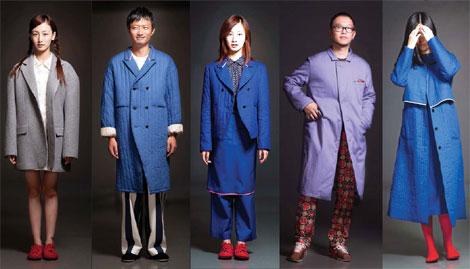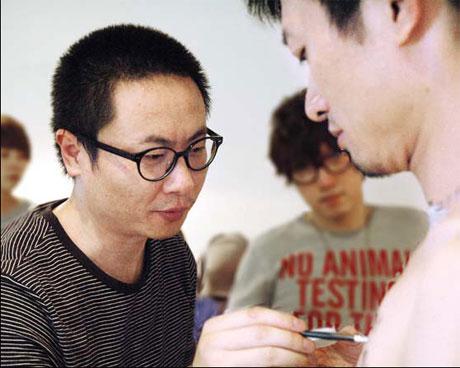
Models pose during designer Zhang Da's fashion show, which previews his Autumn/Winter 2010 collection for men and women.
If the name Zhang Da sounds unfamiliar, nobody can blame you. That is because Zhang has earned a reputation as one of China's most mysterious designers, as he shows little enthusiasm for self-promotion. But, he is well-known for his unique vision, best illustrated by his new label Mei Bian (Boundless) and more recently from his enlistment as the designer for Hermes?up-and-coming China-based label Shang Xia (Topsy-turvy).
Though based in Shanghai, Zhang recently flew to Beijing for a series of design lectures and workshops at 798's Ullens Center for Contemporary Art (UCCA), where he also found time to stage a fashion show on Aug 15, previewing his Autumn/Winter 2010 collection for men and women.
Instead of flashing lights, pounding disco beats, high-concept designs, and willowy models strutting up and down the catwalk in clothes you could never imagine yourself wearing, Zhang's fashion show invited the audience to step out of time and rediscover the fashions of a simpler and more innocent time.
Zhang took us on a trip down memory lane to China during the 1970s and 1980s, when the country was less materialistic than today and appreciated things that were cheap, functional, and, if possible, good-looking.
"But don't mistake me for a nostalgic person, because I am not. Actually, I tend to regard myself as the opposite. Nostalgic elements are only employed to serve as an incisive perspective for the audience to understand my clothes," Zhang said.
The show is the fruit of the collaboration between Zhang and many of his friends. For example, artist Wang Jianwei contributed furnishings made in the 1950s to 1980s that lend authentic period atmosphere. Graphic designer Guang Yu created the main visuals, posters and invitations, and music critic and curator Yan Jun planned the music, an experimental interpretation of sounds from the 1970s and 1980s, performed by Vavabond and Li Daiguo.

Zhang Da paints on a model during a workshop in Beijing.
The setting recalls homes in China more than two decades ago. We saw the familiar plain green and whitewashed walls, fluorescent overhead lights, humble wooden furnishings, stainless steel cups, ceramic bowls and basins. We tasted snacks from our childhood, such as haw flakes, dried instant noodles, and oily corn biscuits. The music was also familiar, evoking the songs we loved to listen to back in the 1970s and 1980s.
"It takes me back to the past and recalls an aesthetic that is applicable to our busy, modern lives today," said Jiang Tao, a film director who acted as a model for the show.
In his latest collection, Zhang makes good use of inexpensive, easy-to-find materials and simple, tried-and-tested techniques: plain blue cloth, sturdy stitching, padded cotton and clean, clear lines. His designs recall the typical hybrid style often seen on the cultural border between China's cities and countryside, where the people often wear both contemporary, Western-influenced clothes and Chinese traditional ones at the same time, without considering their compatibility.
"I'm very keen on observing the way people on the streets of big cities dress themselves and I find migrant workers and those with low incomes dressing the most interestingly. I work to grasp the essence of their aesthetic and make a style out of it," said Zhang.
"In this collection, we encounter a stranger who has come to the city and is seeing certain things for the first time, creating personal connections based on those first, earliest impressions," said graphic designer Liu Zhizhi. Zhang was adamant about his work: "I design clothes, quite simply, for people to wear."
Instead of hiring professional models, Zhang used only amateur models for the show, people from various walks of life, including actor Sha Yi, actress Ye Qing, film director Jiang Tao, his friends from the media, UCCA staffers and some of his fans selected from the Internet. They wore blue padded coats, patterned trousers and black cloth shoes or plain track shoes, and kind of sleepwalked through the crowds, pausing from time to time to smile back at audiences who recognized them.
"There are two reasons for me to use ordinary people instead of professional models. First, this collection tries to create a connection with ordinary people. Second, practically speaking, clothes tailor-made for professional models will be useless if they do not buy them after the show. Nobody else will be able to wear them," Zhang said.
In the eyes of May Xue, director of UCCAStore, Zhang Da is "a person who lends passion, persistence and inimitable creativity to everything he does".
Zhang said that while he is enjoying designing for Hermes at the moment, his ultimate dream is to have his own boutiques nestling around the street corners of residential communities.
Related News
Photos
More>>trade
- Asian Ethical Apparels Exhibition heats up Dalian International Fashion Festival
- Guy Laroche launches its latest collections in Dalian
- Italian Luxury Women's wear brand Giada Opened the 4th Franchised store in China
- Haining China Leather Exhibition to Come
- Chinese premier says no basis for drastic currency appreciation





